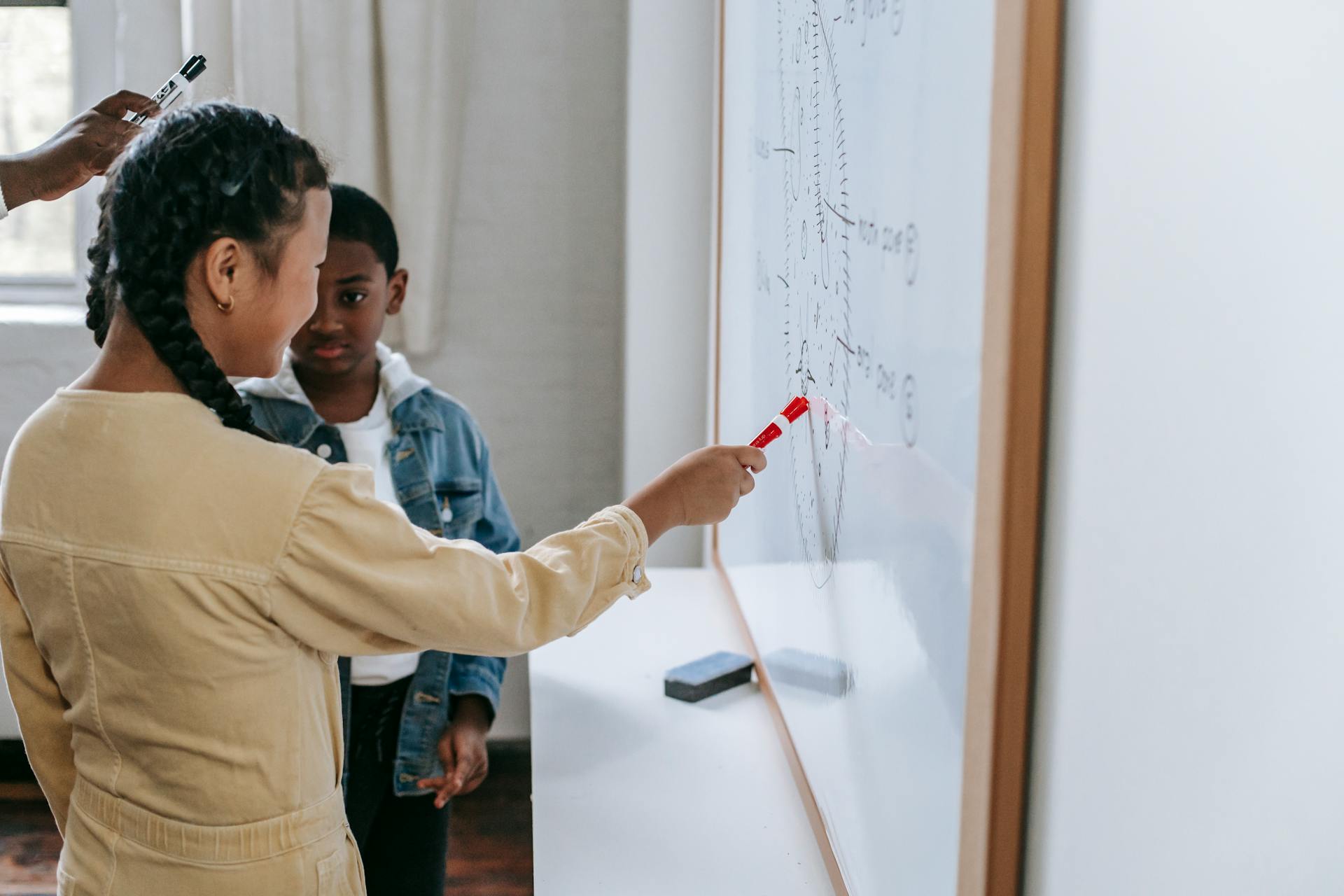
Tensors are a fundamental concept in machine learning, but what exactly are they? A tensor is a multi-dimensional array of numerical values, similar to a matrix, but with more dimensions.
In essence, tensors are mathematical objects used to represent complex data structures in machine learning. They allow us to represent data in a way that's more flexible and powerful than traditional matrices.
Think of a tensor like a cube, where each dimension represents a different aspect of the data. This makes it easier to work with complex data types like images and videos. For example, a 3D tensor could represent a 3D image, with dimensions for height, width, and color channels.
Intriguing read: Tensor Data Preprocessing
What Does It Mean?
Deep learning models are made up of layers that transform input data into something new. Each layer takes some input data, transforms it in some way, and outputs transformed data.
Layers are usually parameterized by tensors, which are data structures that can be thought of as multi-dimensional arrays. They're used extensively in linear algebra.
Discover more: Hidden Layers in Neural Networks Code Examples Tensorflow
A fully connected layer is typically parameterized by two tensors: a weight matrix and a bias vector. When we apply this layer to an input tensor, we multiply the input by the weight matrix and add the bias vector.
Tensors are also used to represent the weights of neural networks. A weight tensor is simply a tensor that is used as a parameter in a layer.
To optimize the values of these weight tensors, we need to minimize some loss functions when we train a neural network.
On a similar theme: What Is a Feature Vector
Tensor Basics
A tensor is a multi-dimensional array of numbers that represents complex data. It's a fundamental data structure used in machine learning and deep learning frameworks like TensorFlow and PyTorch.
In essence, a tensor is a mathematical object that generalizes the concept of scalars, vectors, and matrices to higher dimensions. This means it can handle complex data types like images, videos, and natural language processing.
A tensor has three essential characteristics: number of axes (rank), shape, and data type. The rank refers to the number of dimensions it has, with a vector being a rank-1 tensor and a matrix being a rank-2 tensor.
The shape of a tensor is the size of each dimension. For example, a matrix with 3 rows and 3 columns has a shape of (3, 3). Tensors also have a data type that indicates the type of numbers stored in them, such as float32 or int64.
Here are the key attributes of tensors:
A tensor can be used to represent various types of data, such as images, videos, and natural language processing. For example, a grayscale image can be represented as a mode-2 tensor, while a color image can be represented as a mode-3 tensor.
Tensor Operations
Tensors can be added together, just like vectors and matrices, to combine their values.
You can also multiply tensors, which is a fundamental operation in machine learning and deep learning frameworks like TensorFlow and PyTorch.
The dot product is another operation that can be performed on tensors, allowing you to compute the sum of the products of corresponding entries.
In deep learning, operations like convolution are applied to tensors to extract features from data, making them a crucial part of many algorithms and neural networks.
Just like with vectors and matrices, performing operations on tensors requires a good understanding of their properties and dimensions.
Tensors are multi-dimensional arrays of numbers that represent complex data, making them a powerful tool for data analysis and machine learning.
Tensor Applications
Tensor Applications are diverse and widespread in machine learning. They can be used for image recognition and classification.
Convolutional Neural Networks (CNNs) rely heavily on tensors to process image data. This is because tensors can efficiently represent the complex relationships between pixels in an image.
Tensors can also be used for natural language processing (NLP) tasks, such as text classification and sentiment analysis.
See what others are reading: Binary Classification
Tensor Trains
Tensor Trains are a technique for decomposing tensors into smaller sized tensors, making them more manageable for large-scale data analysis. This approach is particularly useful for higher-dimensional tensors.
Developed in 2011 by Ivan Oseledts, Tensor Trains rewrite the initial tensor as a sequence of smaller tensors, called canonical factors. This allows for the factorization of larger tensors in higher dimensions.
Tensor Trains can be used to reduce the number of elements in the original tensor, resulting in a more compact representation of the data. For example, a 3-way array can be decomposed into a sequence of smaller tensors, reducing the total number of elements by 23%.
The original tensor can be expressed as the sum-product of the sequence of Tensor Trains, making it easier to perform operations on the data. This technique is particularly useful for high-dimensional data, where traditional matrix-based approaches may become impractical.
Tensor Trains are a powerful tool for tensor decomposition, allowing for the analysis of large-scale data in higher dimensions. By breaking down the tensor into smaller components, we can gain insights into the underlying structure of the data.
You might like: Introduction of Statistical Learning Pdf
Fully Connected Layers
Fully Connected Layers are where tensors really shine. They allow you to compute the entire layer of a network at once, rather than individual unit values.
In a fully connected layer, tensors can be used to represent the output values and hidden weights. The output values can be expressed as a mode-1 tensor, while the hidden weights are a mode-2 tensor.
Tensors can efficiently compute the entire layer by mapping the units and weights to tensors. This is similar to matrix multiplication, but with the added flexibility of tensors.
The output values can be computed as a tensor product of the input and weight tensors. This sum-product can be computed efficiently using tensor multiplication.
This formulation enables the entire layer to be computed in a single operation, making it much faster than computing individual unit values.
Check this out: Hidden Technical Debt in Machine Learning Systems
Real-World Data Examples
Real-world data examples are a great way to illustrate the power of tensors. A stock price dataset can be represented as a 3D tensor of shape (250, 390, 3), where each sample corresponds to a day's worth of data.
In this dataset, each minute is encoded as a 3D vector, with 390 minutes in a trading day. This means that each trading day can be represented as a 2D tensor of the form (390, 3).
Tweets can also be stored in a tensor, with each tweet encoded as a 2D tensor of shape (300, 125). This is because each character in the tweet can be represented as a binary vector of size 125, with a single 1 at the character-specific index.
Here's a list of common data types and their corresponding tensor shapes:
- Vector data: 2D tensors (samples, features)
- Sequence or time-series data: 3D tensors (samples, timesteps, characteristics)
- Images: 4D tensors (samples, height, width, channels) or (samples, channels, height, width)
- Video: 5D shape tensors (samples, frames, height, width, channels) or (samples, frames, channels, height, width)
Video data is a great example of a 5D tensor, with each frame encoded as a 3D tensor (height, width, and colour-depth). A 60-second YouTube video clip sampled at 4 frames per second can be stored in a tensor of shape (4, 240, 144, 256, 3).
Images, on the other hand, are typically 3D tensors with a one-dimensional colour channel for grayscale images. A batch of 32 grayscale images of size 64 x 64 can be stored in a tensor of shape (32, 64, 64, 1), while a batch of 32 colour images can be stored in a tensor of shape (32, 64, 64, 3).
Curious to learn more? Check out: Claude 3 Context Window
Tensor vs Other Data Structures
Tensors are often compared to matrices, but they have a significant advantage - they can represent high-dimensional data with fewer indices. For example, an image with a million pixels can be represented as a tensor with only two indices: width and height.
Matrices would have one million indices, making them cumbersome to work with. This is one reason why tensors are preferred in machine learning.
Tensors also have an edge over arrays, which are a fundamental data structure in many programming languages. While arrays are useful for storing and manipulating data, they can't represent complex relationships between different variables.
In contrast, tensors can compactly represent very high-dimensional data, making them ideal for tasks like image and video processing. This is a key reason why tensors are widely used in machine learning applications.
Expand your knowledge: High Bias Low Variance
Tensor in Machine Learning Frameworks
Tensors in machine learning frameworks are used to store and manipulate data. These frameworks provide tools to create tensors, perform computations on them efficiently, and automatically calculate gradients.
Tensors are not just multidimensional arrays, but are designed to run on a GPU for performance. This allows for fast computation of matrix multiplications in parallel.
TensorFlow and PyTorch are two popular deep learning frameworks that handle the creation and manipulation of tensors. They use tensors to build and train complex neural network models.
Deep Learning
In deep learning, tensors are not just n-dimensional arrays, but also have the implicit assumption that they can run on a GPU.
This is a crucial distinction, as deep learning requires performance to compute a lot of matrix multiplications in a highly parallel way.
Tensors in deep learning are generally stored and processed on GPUs to speed up training and inference times.
The biggest difference between a numpy array and a PyTorch Tensor is that a PyTorch Tensor can run on either CPU or GPU.
In deep learning, we need performance to compute a lot of matrix multiplications in a highly parallel way. These matrices (and n-dimensional arrays in general) are generally stored and processed on GPUs to speed up training and inference times.
Curious to learn more? Check out: Hugging Face Run Locally
TensorFlow and PyTorch
TensorFlow and PyTorch are two of the most popular deep learning frameworks, built around tensors. They handle the creation and manipulation of tensors to build and train complex neural network models.
TensorFlow was developed by Google, while PyTorch was developed by Facebook. These frameworks provide the tools to create and manage tensors, making it easier to implement machine learning models.
In deep learning, tensors are not just n-dimensional arrays, but also have the implicit assumption that they can run on a GPU. This is a key difference between a numpy array and a PyTorch Tensor.
TensorFlow and PyTorch are designed to take advantage of this implicit assumption, allowing for faster training and inference times on GPUs. This is especially important for deep learning, where matrix multiplications need to be computed in a highly parallel way.
A fresh viewpoint: Confusion Matrix for Mnist Pytorch
Tensor Data Types
Tensors have a data type that indicates the type of numbers stored in them, such as float32 or int64.
A tensor's data type is an important aspect of its overall structure, as it determines how the numbers are represented and processed.
For example, a tensor with a data type of float32 can store floating-point numbers, whereas a tensor with a data type of int64 can store integers.
In practice, the data type of a tensor can affect the performance and accuracy of machine learning models.
Understanding the data type of a tensor is crucial when working with machine learning frameworks like TensorFlow and PyTorch.
Sources
- https://en.wikipedia.org/wiki/Tensor_(machine_learning)
- https://deepai.org/machine-learning-glossary-and-terms/tensor
- https://towardsdatascience.com/what-is-a-tensor-in-deep-learning-6dedd95d6507
- https://www.analyticsvidhya.com/blog/2022/07/data-representation-in-neural-networks-tensor/
- https://pieriantraining.com/understanding-tensors-in-deep-learning/
Featured Images: pexels.com


